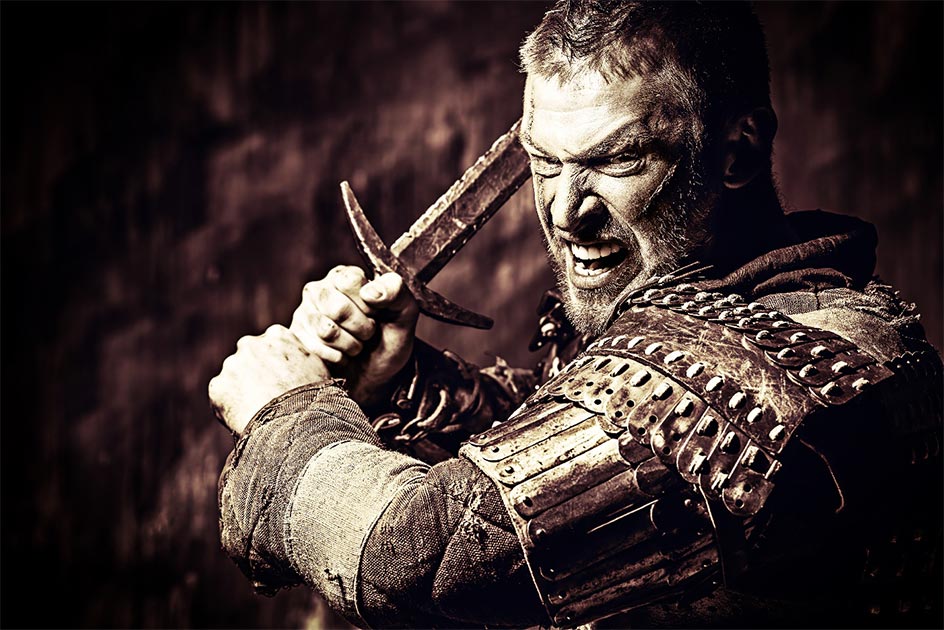The Battle of Tours - A Decisive Fight for Europe’s Future
The early medieval world of our ancestors was built upon struggles and decisive battles. The emerging nations united the broken tribes, expanded their borders, conquered their enemies, and often enough - fended off invaders. But rare are the battles that really left a long lasting impact that echoed through the generations that followed.
Rare are such conflicts that changed the history of the world with their importance and decided the future of us all for centuries to come. And one of those rare, world-changing battles is the Battle of Tours - fought in 732 AD between the Christian Frankish forces and the invading Muslim Umayyad Caliphate.
This fierce and destructive conflict, that shaped the future of Europe and echoed through time, was a great gamble, fought against all odds. But it remains as one of the biggest lessons of Europe’s past, and today we are going in detail about that fated day in 732.
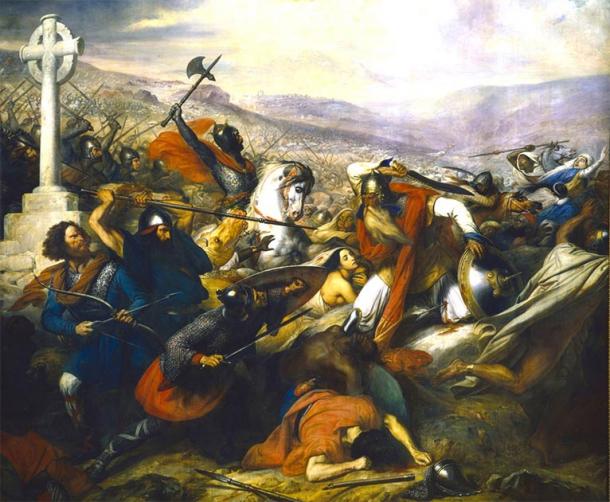
A triumphant Charles Martel (mounted) faces Abdul Rahman Al Ghafiqi (right) at the Battle of Tours. Source: Bender235 / Public Domain.
The Prelude to the Battle of Tours
Around the very beginning of the 8 th century, in the year 700 AD, the Muslim Umayyad Caliphate was rapidly spreading its empire around the world. It was the second of the four great caliphates that emerged after the death of Muhammad and was one of the largest empires of the world at the time.
After conquering the lands of North Africa, they saw mainland Europe as the next prey for their conquests. From the shores of North Africa, they had a clear passage - in the form of the Gibraltar Strait. This would allow their forces to cross over onto the Iberian Peninsula, from which they would spread further inland.
At the time, Iberia was under the control of the Visigothic Kingdom, a centralized state under the rule of King Roderic. Nonetheless, the Umayyads crossed the strait in the year 711 AD, under the leadership of one Tariq ibn Ziyad, and soon after clashed with the Visigothic army in the Battle of Guadalete, in the same year, in the very south of Iberia.
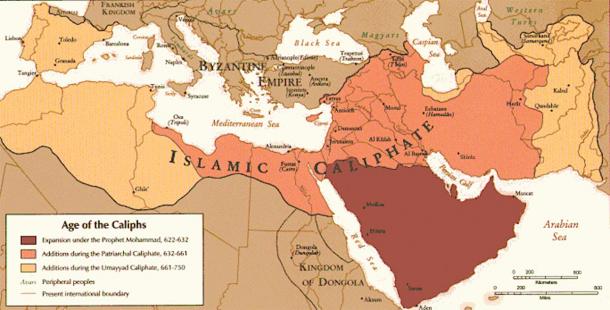
The "Age of the Caliphs", shows the Umayyad dominance stretched from the Middle East to the Iberian Peninsula, including the port of Narbonne, c. 720. (McZusatz / Public Domain)
At the time of the Umayyad invasion, King Roderic was far in the north, attempting to fight a Basque rebellion. This unfortunately placed him in a bad situation, as he was forced to a long march south, to face this much bigger enemy. In the end, the Visigoths were defeated in the face of the overwhelming Muslim cavalry.
In the battle, King Roderic and most of the nobles of his kingdom lost their lives, which allowed the Umayyads to effectively conquer Iberia, step by step. This they managed in just a little under seven years. And once Iberia was theirs, Frankish Gaul was just a step away.
The only thing that divided the Umayyads from their prey - the Frankish Kingdom - were the Pyrenees Mountains. This was a fitting natural barrier - but it was in no way untraversable. In time, the Umayyads began crossing over and making incursions into the very south of Gaul. By 720 they conquered the southern province of Septimania.
In the following year, they focused on the large city to the immediate west, Toulouse, which they besieged. This siege was brought to an end by the prominent Frankish Duke Odo - who managed to overwhelm the Umayyad forces outside Toulouse and defeat them. Nonetheless, large numbers of Umayyads kept crossing over the Pyrenees and laying waste to the southern provinces of Gaul.
The Duchy of Aquitaine laid in the south and faced the brunt of this invasion. Its largest towns, Bordeaux and Toulouse were ravaged, and in no time the invaders reached even the Duchy of Burgundy to its north.
But it wasn’t until 732 that the Umayyad Caliphate truly amassed its forces with proper conquering intentions and adequate strength. The man that was at the head of this force was Abdul Rahman al Ghafiqi, the then-Governor General of Muslim Iberia. He led his forces across the Pyrenees once again and plundered the land and all the cities he came across.
- Unique Iberian Male DNA was Practically Wiped Out by Immigrant Farmers 4500 Years Ago [New Study]
- Raiders of Hispania: Unravelling the Secrets of the Suebi
- Was the First Islamic Siege of Constantinople (674 – 678 AD) a Historical Misnomer?
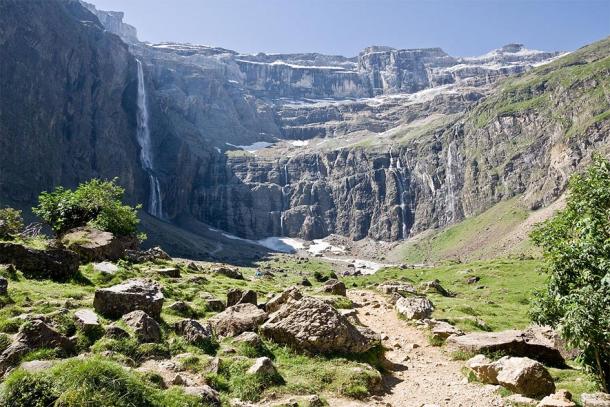
Abdul Rahman al Ghafiqi led his troops over the Pyrenees Mountains toward the Battle of Tours. (Jean-Christophe BENOIST / CC BY-SA 3.0)
The Umayyads greatly coveted riches, and their main activity during this conquest was plunder. After completely ransacking Bordeaux once again, the Umayyad forces faced Duke Odo once more. Odo led his army in an attempt to stop the invasion as he did a few years before.
But this time, he was terribly outnumbered and outmaneuvered, and his forces were crushed. Realizing the gravity of the situation, and that his own lands of Aquitaine were overrun, Odo fled to the north seeking assistance from the de-facto ruler of the Frankish Kingdom - Charles Martel.
Before the Umayyad invasion Odo and Charles were enemies. Charles sought to expand his lordship over Aquitaine and Odo saw the Franks as invaders. But with this new and much greater threat, Odo had no choice but to seek help from the Franks. Charles Martel agreed to join up with him, but the “price” was Odo’s acceptance of Frankish overlordship. Odo agreed.
The Hammer Enters the Fray
Charles Martel was a seasoned ruler and a battle hardened veteran. His troops were equally experienced having been in constant clashes along the eastern borders of their kingdom, fighting neighboring tribes.
Charles also understood how important the situation was and began gathering his levies from all over the north. And he would show his shrewdness as a battle commander, when he carefully understood the intentions of his enemy.
Meanwhile, the Umayyad forces moved slowly across the Frankish lands, their forces spread into war parties that ravaged the countryside and amassed an enormous amount of plunder. This “greedy” focus on war booty would greatly influence their future undoing. They had to take their time, as they greatly depended on the crop season for their food source.
But their destination was clear to Charles Martel. It was the rich city of Tours - prominent and wealthy, filled with abbeys of great importance. Thus, Charles placed his Frankish forces directly on the path of the coming Umayyads. He situated his army roughly in between the city of Tours and the ravaged town of Poitiers further south.
The Franks were placed close to the confluence of rivers Clain and Vienne, on a slightly elevated and forested hill. Charles Martel deliberately and shrewdly chose this position. First of all - he was outnumbered and knew it.
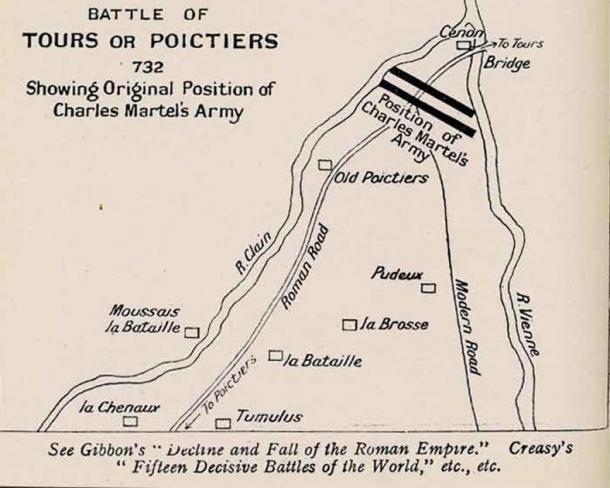
Map of the Battle of Tours with the position of Charles Martel's army. (Evzen M / Public Domain)
Thus he chose the cover of the forest to displace his troops and hide his number in hope to not reveal his disadvantage. Secondly - he chose a place where the Umayyads would have to enter into battle, as the only crossing over the rivers was behind the Frankish forces. Thirdly - the forest protected his troops - mainly the second lines - from the full brunt of a cavalry charge, and somewhat protected his sides from flanking attacks.
When the Umayyads approached the assembled Christian army, their leader Abdul Rahman al Ghafiqi - also a seasoned commander - knew that Charles Martel took the upper hand, by choosing his preferred place of battle. Even so, al Ghafiqi trusted in his strength and deployed for battle.
One thing he must have noticed is the difference in the troops - Umayyads relied heavily on cavalry, while the Franks were mostly footmen. But he failed to take several things into account.
The Muslim cavalry was lightly armored - they preferred to adorn themselves with chainmail and not much else in terms of armor. Riches and trinkets were much more to their liking.
They also rode willful Arabic horses, which were difficult to break in, and thus not the truly perfect cavalry mounts. Some historians also mention that this cavalry was in large part armed with spears - which were unseasoned and would break on first impact.
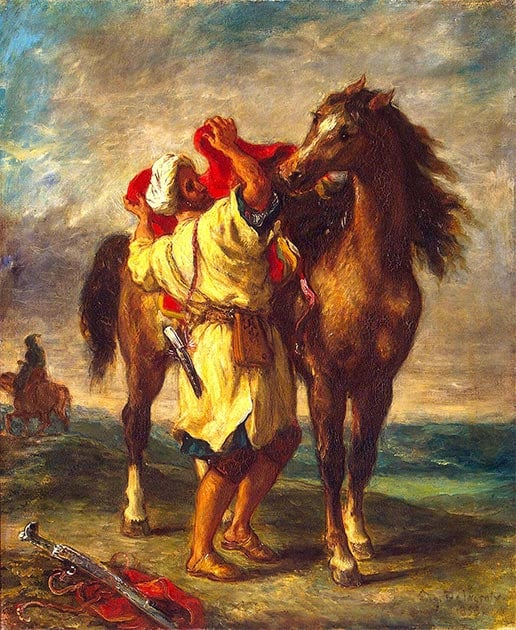
The Muslim cavalry rode willful Arabic horses during the Battle of Tours. (Trzęsacz / Public Domain)
On the other hand, the Frankish infantry was thoroughly seasoned. Most of the army were veterans, with only a small part of fresh recruits reserved in the second lines. They were well armored for the time, and well-armed as well. They stood packed in tight lines and ready for a cavalry charge.
But the battle did not begin immediately. The opposing forces “tested the waters”, with sporadic small skirmishes going on for seven days.
This was in truth a deliberate stalling from al Ghafiqi, who waited for his whole army to assemble fully. In the end, with the Umayyads fearing the approaching winter, they commenced battle on the seventh day - on the 10th of October 732 AD.
The Umayyad Wave That Broke On the Frankish Rock
The Umayyad commander, al Ghafiqi, heavily relied on his cavalry, even though he didn’t possess much knowledge about the assembled enemy. He sent waves of cavalry charges in an attempt to break the Frankish lines - but this did not happen. The seasoned Franks were tightly packed - shoulder to shoulder - and withstood all assaults.
The rare combination of slight elevation, good arms and armor, and tree cover allowed them to hold their ground - when it was almost impossible for infantry to hold against cavalry in medieval times. Even when some small parts of the line faltered and broke under the cavalry, the fresh second lines were quick to react - sealing the gap.
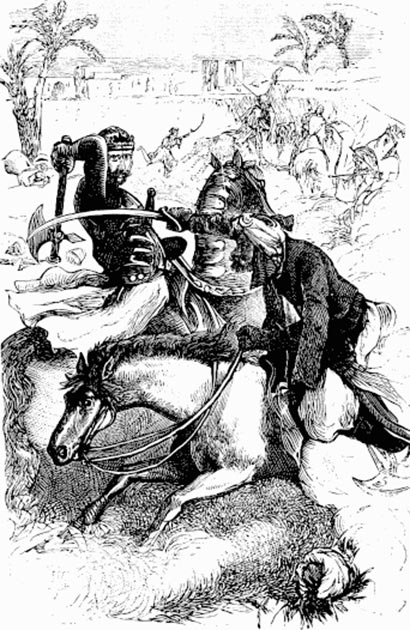
Frankish knight fighting against an Umayyad horseman. (Helix84 / Public Domain)
As the battle went on in that way, Duke Odo commenced a crucial flanking operation that greatly tipped the scales in Frankish favor. He gathered a cavalry force and flanked wide - reaching the distant Muslim encampment - i.e. their rear. This was where the Umayyad tents were and all of their abundant plunder.
Odo managed to inflict great losses here, retrieve the precious plunder, free around 200 captive Franks, and draw the eye of the enemy. But what happened next was more than he hoped for. Upon realizing that their camp and their plunder were under attack, many Umayyad units from the central battlefield rushed back in a frenzy to save their loot.
This was an unprecedented situation, one that al Ghafiqi never expected. His attempts at rallying his troops were in vain, and Charles Martel - who knew exactly what he was doing - seized this opportunity.
As the Umayyad forces dissipated to retrieve the loot, he swung his forces from left, right, and center, and engaged in both pursuit and encirclement. The remaining body of the Umayyads was surrounded and suffered immense casualties.
The chief of these was al Ghafiqi himself - who fell in battle while attempting to rally his troops. Meanwhile, Duke Odo swung north again and cut off the fleeing Umayyads, inflicting great losses. In effect, the Umayyad forces fled.
- The Heroic Story of Roland: A Valiant Knight With an Unbreakable Sword
- Cataphracts: Armored Warriors and their Horses of War
- The Mighty Magyars, a Medieval Menace to the Holy Roman Empire
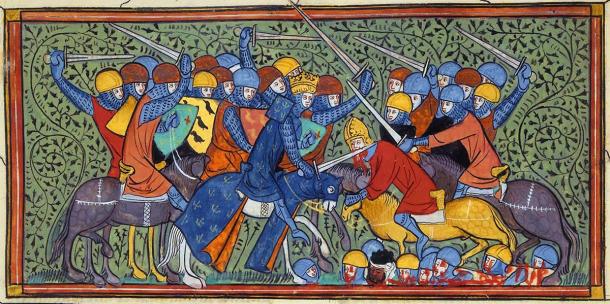
Charles Martel gathered his cavalry at Battle of Tours and attacked the Umayyad encampment. (Levan Ramishvili / Public Domain)
Now, Charles Martel expected a second day of battles and remained in his position, treating the wounded and re-organizing. But another day never came. The Umayyads, with their commander dead, could not successfully organize another attack or choose a fitting leader. They had suffered great losses as well.
Charles Martel feared an ambush and would not descend from the hill at any cost. Eventually, he sent out extensive reconnaissance parties to survey the Umayyad forces - but only to learn that there were none. They had gathered all the remaining plunder they could and fled during the night - extremely hastily. They had returned to Iberia.
Charles Martel won a crushing and glorious victory that cemented his reputation of a noble and capable leader. He was praised all across Europe as the savior of the Christendom and the “Hammer that Broke the Muslims”. Thus he earned his nickname - Martel - meaning Charles the Hammer.
He subsequently expanded his rule over Aquitaine and successfully isolated the invaders to the southern region of Septimania, where they remained for another 27 years and were completely unable to break through. Charles’ wealth, influence, power, and ability led to the emergence of the Carolingian dynasty, which would rise and last for centuries to follow.
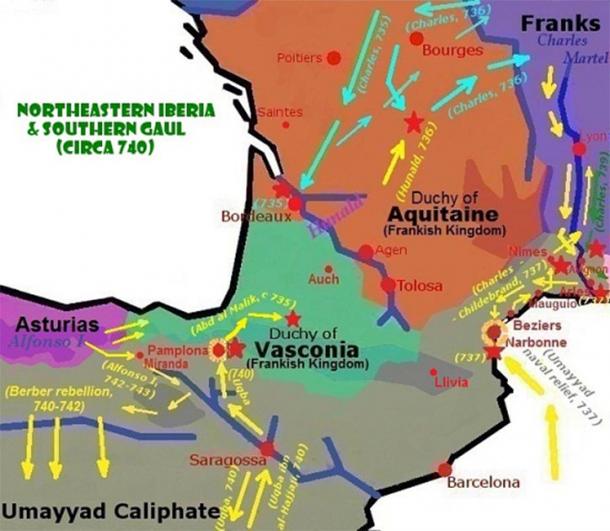
Charles Martel's military campaigns in Aquitaine, Septimania, and Provence after the Battle of Tour-Poitiers (734–742). (Iñaki LLM / CC BY-SA 3.0)
Changing the Future of the World
The Europe of the early 18 th century desperately needed a capable and strong commander that would stop the Muslim Umayyad invaders dead in their tracks. And that commander was Charles Martel. He stood up to ravaging flood of conquerors and using his superior tactics, shrewdness, and reputation, he managed to win a crushing battle - against all odds. Like a beacon that kept burning throughout a storm, his Frankish warriors defied their enemy in battle. And it is this battle that changed the course of European history, and with that - the history of the World.
Top image: Medieval soldier at war. Credit: Andrey Kiselev / Adobe Stock
References
Creasy, E. 2016. The Fifteen Decisive Battles of the World. Enhanced Media.
Neiberg, M. 2003. Warfare in World History. Taylor & Francis.
Scott, J. 2011. Battle of Tours - A New Look at an Old Enemy. eBookIt.


















